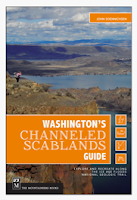 |
| Joe Friday and his buddy Spike -- just umbel cops, but they always get their man. |
About the author: Punster Extraordinaire John Baxter grew up in Burns, a very small town in the Chalk Bluff country of southeast Wyoming. He used to tell us there was a statue of him there; I think he was joking but I still haven't checked. John started his education in the one-room school in Burns (he and his brother were the only pupils one year), and went on to become Professor of Mycology at the University of Wisconsin in Milwaukee. His other claim to fame was that he was the father-in-law of a
Talking Head.
When I met John, he was retired, living in Laramie with wife Jane, and busy with mycology projects at the University. The state biological inventory where I worked was tucked into a corner of the Solheim Mycological Herbarium ... thus our paths were destined to cross. We became very fond of John and his wonderful irrepressible sense of humor. It provided a bit of sunshine to our underfunded under-appreciated existence.
John Baxter passed away August 23, 2002, but he lives on in our memories.
Guest post by John “Barney” Baxter, sent from parts unknown.
To assist the uninitiated, all technical terms have live links.
My name is Joe Friday. I was born in
Raceme, Wisconsin. My buddy
Spike and I are just
umbel cops, but we can go anywhere a
catkin, and we always get our man.
It was warm in Los Angeles. It was so warm that Spike and I were beginning to
drupe, and we were about to go to
Abies bar and get
plastid, when a call came in that a supermarket had been held up. We drove down there and talked to a checker. She was
palea and nervous. “Don’t
panicle, Ma’am,” I said, “I just want the FAX.” “Well,
lemma see,” she said, “this guy came in with a
pistil, and I knew he meant to
stigma up, so I gave him all the cash. Then I watched him
pedicel away on his
pericycle. It had one
petal missing.”
 |
| this guy came in with a pistil ... so I gave him all the cash |
I could tell by the
style of the
caper that it was the work of Pericycle Pete, the notorious supermarket bandit. We spent a week looking for
apetalous pericycle, with no success. We were deep in
glume. Then one day there was a knock
awn the door. “Come in,” I said, and who should walk in but Sadie the Shoplifter, a gal whose favorite trick was to
Caryophyllaceae bit of feminine apparel from some display counter. “Boys,” said Sadie, “I’ve
stolon my last bit of lingerie -- I’m
Cereus, I’m going to lead you to Pericycle Pete’s hangout.”
His only anther was to fire a pistil from a window. We let him rachis with fire for awhile, then we broke down the door. He had exhausted his ammunition, and the floor was littered with Brassicaceaes. “Boys” he said, “I’m glad it’s over. I lost my shoes, and mitosis cold.”
 |
| I lost my shoes, and mitosis cold |
Sadie warned us that the
sapwood try to escape, so we took him to the station and locked him up in a
guard cell. We put Sadie in a nearby
companion cell. Later she cracked up, so we sent her to the insane
xylem. Then our Irish police chief,
Luke O’Plast, gave me a raise so now I have a
funiculus to jingle in my pocket. I also have my name over my office door
inflorescence lights, and I feel quite
superior ovary the whole thing. --
Ament
 |
| we took him to the station and locked him up in a guard cell |


















